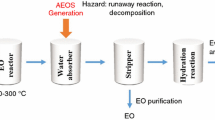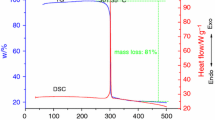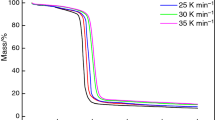Abstract
This contribution explores the capabilities of combined thermal analysis methods to predict the ignition condition for a thermal runaway event to occur in a system heated at a constant rate. In particular, for a Ce triethanolamine complex, thermogravimetry has been used to determine the kinetic parameters, while enthalpy, thermal conductivity and thermal capacity have been measured by means of DSC. Once these parameters are known, it is possible to predict the critical mass for different heating rates and crucible sizes. Besides, thermogravimetry allowed us to assess if thermal runaway occurred as well as to monitor its evolution. Good agreement between the predicted and the experimental critical masses has been observed.






Similar content being viewed by others
References
Merzhanov AG, Khaikin BI. Theory of combustion waves in homogeneous media. Prog Energy Combust Sci. 1988;14:1–98.
Adler J, Enig JW. The critical conditions in thermal explosion theory with reactant consumption. Combust Flame. 1964;8:97–103.
Zaldívar JM, Cano J, Alós MA, Sempere J, Nomen R, Lister D, et al. A general criterion to define runaway limits in chemical reactors. J Loss Prev Process Ind. 2003;16:187–200.
Roduit B, Xia L, Folly P, Berger B, Mathieu J, Sarbach A, et al. The simulation of the thermal behavior of energetic materials based on DSC and HFC signals. J Therm Anal Calorim. 2008;93:143–52.
Krause G. Volume-dependent self-ignition temperatures for explosive materials. Propellants Explos Pyrotech. 2012;37:107–15.
Roduit B, Hartmann M, Folly P, Sarbach A, Brodard P, Baltensperger R. Determination of thermal hazard from DSC measurements. Investigation of self-accelerating decomposition temperature (SADT) of AIBN. J Therm Anal Calorim. 2014;117:1017–26.
Dellavedova M, Pasturenzi C, Gigante L, Lunghi A. Kinetic evaluations for the transportation of dangerous chemical compounds. Chem Eng Trans. 2012;26:585–90.
Boddington T, Cottrell A, Laye PG. A numerical model of combustion in gasless pyrotechnic systems. Combust Flame. 1989;76:63–9.
Zinn J, Mader CL. Thermal initiation of explosives. J Appl Phys. 1960;31:323.
Rogers RN. Thermochemistry of explosives. Thermochim Acta. 1975;11:131–9.
Victor AC. Simple calculation methods for munitions cookoff times and temperatures. Propellants Explos Pyrotech. 1995;20:252–9.
Kotoyori T. Critical temperatures for the thermal explosion of chemicals. Ind. Saf. Ser. 1st ed. Amsterdam: Elsevier; 2005.
Griffiths JF, Barnard JA. Flame and combustion. 3rd ed. London: CRC Press; 1995.
Phung PV, Hardt AP. Ignition characteristics of gasless reactions. Combust Flame. 1974;22:323–35.
Morsi K. The diversity of combustion synthesis processing: a review. J Mater Sci. 2011;47:68–92.
Moore JJ, Feng HJ. Combustion synthesis of advanced materials: part I. Reaction parameters. Prog Mater Sci. 1995;39:243–73.
Varma A, Rogachev AS, Mukasyan AS, Hwang S. Combustion synthesis of advanced materials: principles and applications. Adv Chem Eng. 1998;24:79–226.
Patil KC, Aruna ST, Mimani T. Combustion synthesis: an update. Curr Opin Solid State Mater Sci. 2002;6:507–12.
Mossino P. Some aspects in self-propagating high-temperature synthesis. Ceram Int. 2004;30:311–32.
Yeh C-L. Combustion synthesis: principles and applications. In: Buschow KHJ, Cahn RW, Flemings MC, Ilschner B, Kramer EJ, Mahajan S, et al., editors. Encyclopedia of materials, science and technology. 2nd ed. Oxford: Elsevier; 2010. p. 1–8.
Reeves RV, Rodriguez MA, Jones ED, Adams DP. Condensed-phase and oxidation reaction behavior of Ti/2B foils in varied gaseous environments. J Phys Chem C Am Chem Soc. 2012;116:17904–12.
Wang J, Besnoin E, Knio OM, Weihs TP. Effects of physical properties of components on reactive nanolayer joining. J Appl Phys. 2005;97:114307.
Striker T, Ruud JA. Effect of fuel choice on the aqueous combustion synthesis of lanthanum ferrite and lanthanum manganite. J Am Ceram Soc. 2010;93:2622–9.
Varma A, Mukasyan AS, Rogachev AS, Manukyan KV. Solution combustion synthesis of nanoscale materials. Chem Rev. 2016;116:14493–58686.
Rabinovich OS, Grinchuk PS, Andreev MA, Khina BB. Conditions for combustion synthesis in nanosized Ni/Al films on a substrate. Phys B Condens Matter. 2007;392:272–80.
Thiers L, Mukasyan AS, Varma A. Thermal explosion in Ni–Al system: influence of reaction medium microstructure. Combust Flame. 2002;131:198–209.
Frank-Kamenetskii DA. Diffusion and heat exchange in chemical kinetics. 2nd ed. New Jersey: Princeton University Press; 1955.
Semenov N. Thermal theory of combustion and explosion. Prog Phys Sci USSR. 1940;23:251–92.
Kassoy DR, Liñan A. The influence of reactant consumption on the critical conditions for homogeneous thermal explosions. Q J Mech Appl Math. 1978;31:99–112.
Gray P, Harper MJ. Thermal explosions. Part 1. Induction periods and temperature changes before spontaneous ignition. Trans Faraday Soc. 1959;55:581–90.
Todes OM, Melentjew PV. The theory of heat explosion II Heat explosion for mono-molecular reactions. Acta Physicochim URSS. 1939;11:153–80.
Squire W. A mathematical analysis of self-ignition. Combust Flame. 1963;7:1–8.
Gray P, Lee PR. Thermal explosions and the effect of reactant consumption on critical conditions. Combust Flame. 1965;9:201–3.
Lacey AA. Critical behaviour of homogeneous reacting systems with large activation energy. Int J Eng Sci. 1983;21:501–15.
Babushok VI, Goldshtein VM, Sobolev VA. Critical conditions for thermal explosion with reactant consumption. Combust Sci Technol. 1990;70:81–9.
Thomas PH. Effect of reactant consumption on the induction period and critical condition for a thermal explosion. Proc R Soc A Math Phys Eng Sci. 1961;262:192–206.
Morbidelli M, Varma A. A generalized criterion for parametric sensitivity: application to thermal explosion theory. Chem Eng Sci. 1988;43:91–102.
Sánchez-Rodriguez D, Farjas J, Roura P. The critical condition for thermal explosion in an isoperibolic system. AIChE J. 2017;63:3979–93.
Sánchez-Rodriguez D, Farjas J, Roura P. The critical conditions for thermal explosion in a system heated at a constant rate. Combust Flame. 2017;186:211–9.
Vyazovkin S, Wight CA. Kinetics in solids. Annu Rev Phys Chem Annu Rev. 1997;48:125–49.
Sánchez-Rodríguez D, Yamaguchi S, Ihara D, Yamaura H, Yahiro H. Self-propagating high-temperature synthesis of highly dispersed noble metals on ceria powder: application to Pd/CeO2 catalyst. Ceram Int. 2017;43:14533–6.
Wattanathana W, Wannapaiboon S, Veranitisagul C, Laosiripojana N, Koonsaeng N, Laobuthee A. Preparation of palladium-impregnated ceria by metal complex decomposition for methane steam reforming catalysis. Adv Mater Sci Eng. 2017;2017:1–10.
Wattanathana W, Veranitisagul C, Wannapaiboon S, Klysubun W, Koonsaeng N, Laobuthee A. Samarium doped ceria (SDC) synthesized by a metal triethanolamine complex decomposition method: characterization and an ionic conductivity study. Ceram Int. 2017;43:9823–30.
Wattanathana W, Nootsuwan N, Veranitisagul C, Koonsaeng N, Laosiripojana N, Laobuthee A. Simple cerium-triethanolamine complex: synthesis, characterization, thermal decomposition and its application to prepare ceria support for platinum catalysts used in methane steam reforming. J Mol Struct. 2015;1089:9–15.
Liu K, Zhong M. Synthesis of monodispersed nanosized CeO2 by hydrolysis of the cerium complex precursor. J Rare Earths. 2010;28:680–3.
Pati RK, Lee IC, Gaskell KJ, Ehrman SH. Precipitation of nanocrystalline CeO2 using triethanolamine. Langmuir. 2009;25:67–70.
Zghal I, Farjas J, Camps J, Dammak M, Roura-Grabulosa P. Thermal decomposition of cerium triethanolamine complexes. Thermochim Acta. 2020;683:178430.
İçbudak H, Yilmaz VT, Ölmez H. Thermal decomposition behaviour of some trivalent transition and inner-transition metal complexes of triethanolamine. Thermochim Acta. 1996;289:23–322.
Farjas J, Roura P. Isoconversional analysis of solid state transformations. A critical review. Part I. Single step transformations with constant activation energy. J Therm Anal Calorim. 2011;105:757–66.
Farjas J, Roura P. Isoconversional analysis of solid state transformations. A critical review. Part II. Complex transformations. J Therm Anal Calorim. 2011;105:767–73.
Brown ME, Maciejewski M, Vyazovkin S, Nomen R, Sempere J, Burnham A, et al. Computational aspects of kinetic analysis: part A: the ICTAC kinetics project-data, methods and results. Thermochim Acta. 2000;355:125–43.
Vyazovkin S, Burnham AK, Criado JM, Pérez-maqueda LA, Popescu C, Sbirrazzuoli N. ICTAC Kinetics Committee recommendations for performing kinetic computations on thermal analysis data. Thermochim Acta. 2011;520:1–19.
Friedman HL. Kinetics of thermal degradation of char-forming plastics from thermogravimetry. Application to a phenolic plastic. J Polym Sci Part C Polym Symp. 1964;6:183–95.
Vyazovkin S. Modification of the integral isoconversional method to account for variation in the activation energy. J Comput Chem. 2001;22:178–83.
Li C-R, Tang TB. A new method for analysing non-isothermal thermoanalytical data from solid-state reactions. Thermochim Acta. 1999;325:43–6.
Li C-R, Tang TB. Dynamic thermal analysis of solid-state reactions. J Therm Anal. 1997;49:1243–8.
Ortega A. A simple and precise linear integral method for isoconversional data. Thermochim Acta. 2008;474:81–6.
Pujula M, Sánchez-Rodríguez D, Lopez-Olmedo JP, Farjas J, Roura P. Measuring thermal conductivity of powders with differential scanning calorimetry. J Therm Anal Calorim. 2016;125:571–7.
Sánchez-Rodríguez D, López-Olmedo JP, Farjas J, Roura P. Determination of thermal conductivity of powders in different atmospheres by differential scanning calorimetry. J Therm Anal Calorim. 2015;121:469–73.
Sánchez-Rodríguez D, Eloussifi H, Farjas J, Roura P, Dammak M. Thermal gradients in thermal analysis experiments: criterions to prevent inaccuracies when determining sample temperature and kinetic parameters. Thermochim Acta. 2014;589:37–46.
Farjas J, Sánchez-Rodriguez D, Eloussifi H, Roura P. Thermal gradients in thermal analysis experiments. In: Šesták J, Hubík P, Mareš JJ, editors. Thermal physics and thermal analysis: from macro to micro, highlighting thermodynamics, kinetics and nanomaterials. Budapest: Springer; 2017. p. 345–362.
Mukasyan AS, Rogachev AS. Discrete reaction waves: gasless combustion of solid powder mixtures. Prog Energy Combust Sci. 2008;34:377–416.
Roura P, Sanchez-Rodriguez D, Farjas J. Measurement by differential scanning calorimetry of specific heat capacity variation due to crystallization: application to amorphous silicon. Thermochim Acta. 2011;522:161–5.
García E, Sánchez-Rodríguez D, López-Olmedo JP, Farjas J, Roura P. The effect of volatiles on the measurement of the reaction heat by differential scanning calorimetry. J Therm Anal Calorim. 2015;121:187–94.
Merzhanov AG, Barzykin VV, Shteinberg AS, Gontkovskaya VT. Methodological principles in studying chemical reaction kinetics under conditions of programmed heating. Thermochim Acta. 1977;21:301–32.
Kissinger HE. Reaction kinetics in differential thermal analysis. Anal Chem. 1957;29:1702–6.
Roura P, Farjas J. Analytical solution for the Kissinger equation. J Mater Res. 2009;24:3095–8.
Farjas J, Roura P. Exact analytical solution for the Kissinger equation: determination of the peak temperature and general properties of thermally activated transformations. Thermochim Acta. 2014;598:51–8.
Acknowledgements
This work was funded by Ministerio de Ciencia, Innovación y Universidades (Grant Number RTI2018-095853-B-C22), and by the Generalitat of Catalunya (2017-SGR-1519).
Author information
Authors and Affiliations
Corresponding author
Additional information
Publisher's Note
Springer Nature remains neutral with regard to jurisdictional claims in published maps and institutional affiliations.
Rights and permissions
About this article
Cite this article
Zghal, I., Farjas, J., Camps, J. et al. Use of thermal analysis to predict the conditions for thermal explosion to occur: application to a Ce triethanolamine complex. J Therm Anal Calorim 142, 2087–2094 (2020). https://doi.org/10.1007/s10973-020-10262-4
Received:
Accepted:
Published:
Issue Date:
DOI: https://doi.org/10.1007/s10973-020-10262-4




